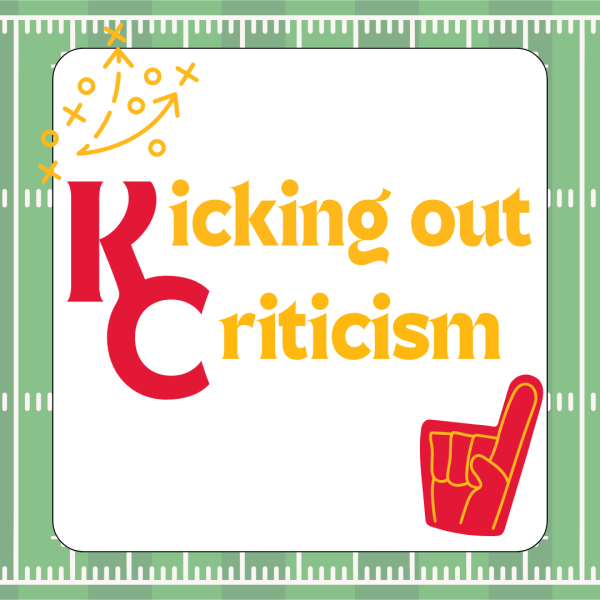Men shouldn’t be restrained by the typical view of masculinity
According to The Good Men Project, toxic masculinity can be defined as a “narrow and repressive description of manhood, designating manhood as defined by violence, sex, status and aggression. It’s the cultural ideal of manliness, where strength is everything while emotions are a weakness.” Before going any further with explaining what toxic masculinity is, it’s of the utmost importance to note that masculinity in itself is not toxic—it is when the cultural expectations and pressures placed on men are distorted to the extreme and become dangerous to both men and society as a whole. Senior Patrick Fowler said he finds masculinity to include good, natural traits of all males as a whole.
“One of the big things I see of masculinity is the ability to have to exclaim your emotions and thoughts and what you believe in through masculinity, and I see people taking ownership—like on the football field—taking ownership and command of the team as a captain, things like that,” Fowler said.
While it’s important to realize that masculinity on its own is not dangerous, it is necessary to realize the growing issue of toxic masculinity in our society. There are certain aspects of what it means to be a man that have been warped into a dangerous weapon against boys in our culture. This is when masculinity can be labeled as toxic. Senior Jada Harper said our current way of thinking about masculinity is ‘pushing [men] into a corner’.
“Toxic masculinity is when boys and men suppress their feelings so that they appear to be ‘manly’,” Harper said. “This is important because this is a damaging status quo that we place upon them, trying to change who they are and shape them into something that they aren’t.”
The harmful impacts of a dangerous view of what a man is supposed to be can be seen every day. There’s a common stereotype of women being overly emotional, while men never shed a tear. Like any stereotype, it is confining and prevents men from saying or doing things that aren’t manly or have been deemed as feminine. Harper said she’s seen how the views of masculinity and femininity impact boys in her daily life.
“Another female classmate comes in and I notice her pants so I told her that they were super cute and that they were a great color on her,” Harper said. “She said thanks and got the stuff she needed to go back into the hallway. Once she left, the guy in my classroom started saying how I was lucky to be a girl so I can say stuff like that and if he did then he would be classified as ‘gay’. I immediately tried telling him that there isn’t only one group of people who can say that they look nice because that’s just absurd, but he insisted on not doing anything like that.”
While this is just one example, it’s not rare to see similar instances occur in daily life. Although the boy in this story felt as though he wasn’t allowed to make a comment on a feminine topic for fear of the judgment from others, boys are also prevented from partaking in certain activities if they are seen as being typically a girl’s activity (i.e., fashion). Senior Claire Rips-Goodwin said she’s seen an example of this in her own family.
“My nephew’s mother is forcing my nephew to do wrestling and baseball even though he doesn’t like them,” Rips-Goodwin said. “He’s openly said he hates them, even though he’s expressed interest in things like dance and music. I just think that especially young kids should be allowed to explore what they want to do freely instead of having to fit into a strict and archaic binary.”
Clearly, this is an issue that is not being imagined. The results of toxic masculinity can be seen everywhere, in every aspect of social interaction for men, yet many people doubt its existence or that it is actually harmful to men. Therefore, the question of how exactly toxic masculinity hurts men must be addressed.
According to the newly released APA Guidelines for Psychological Practice with Boys and Men, “Traditional masculinity ideology has been shown to limit males’ psychological development, constrain their behavior, result in gender role strain and gender role conflict and negatively influence mental health and physical health.” The ideas that come with toxic masculinity are that men should suppress their emotions, toughen up, and be strong. These expectations can have long-term psychological damage, as men don’t feel as though they can express their emotions and be vulnerable. Harper said the media plays into placing certain expectations on men, and not being able to express emotions is one of the main issues represented.
“Some pressures that I think they face are suppressing their emotions which in turn leads to violence because they don’t have any other way to express themselves,” Harper said. “Even if they try to express themselves, it needs to be something “manly” like shooting, axe throwing or shouting at the TV when playing games. Society doesn’t allow them to do anything besides fill their given role of being the brave homemaker.”
It’s easy for the term ‘toxic masculinity’ to be upsetting to some men, as at first glance it seems as though they are being attacked for being masculine. Yet, this is not the goal. The groups fighting against toxic masculinity want to reverse the harmful impacts it has on men. Every group of people has certain stereotypes and expectations assigned to them by our society, whether they are consciously recognized or not. In many cases, these are traditional views of thinking that have never been challenged, but perhaps should be. Rips-Goodwin said the pressure to fit in—which impacts everyone—influences men when it comes to toxic masculinity as well.
“I don’t necessarily think it’s about every single boy being
like, ‘I want to be a big, strong man,’” Rips-Goodwin said. “I think that’s also a big thing with that, is that a lot of people—especially most young people—don’t really know who they are, so they’re just like leaning into what society tells them they should be. I think a lot of young boys do want to be what society tells them to be, and I think a big process of growing up is realizing that our culture can be flawed and complex and you don’t have to fit into its archetypes to be considered a fully-fledged, complex human being.”
While the most important aspect of the damage toxic masculinity can do is its impact on men, it’s important to acknowledge how it hurts other groups of people. When a man—or anyone—chooses to shove their feelings down, those emotions often come out in an unhealthy and unwanted manner later on. Rips-Goodwin said toxic masculinity impacts women as well as men.
“The biggest thing is that it directly bleeds into violence against women,” Rips-Goodwin said. “Because men aren’t allowed to have healthy and suitable outlets for aggression and anger and sadness and depression even, sometimes they end up taking it out on women. Domestic violence or even big, large-scale acts of violence like school shootings can be linked to this as well.”
Equally as important as toxic masculinity’s affect on women is its harm to young children. As children are incredibly impressionable and are constantly learning how to be a part of society and finding who they should be, the ideas of toxic masculinity form their view of gender differences. Harper said young boys internalize these ideas.
“This view is dangerous for young children because it can be imposed on them and then they can start to inhabit these ideas,” Harper said. “Especially if they start to hear these ideas when they are really young, then they will keep those ideas for the rest of their lives unless we change it.”
Toxic masculinity can harm young girls just as easily as it harms young boys. If boys are learning what they can and cannot do from what it means to ‘be a man’, young girls are also learning what they can and cannot do. Rips-Goodwin said how boys handle themselves and their emotions harms girls.
“It can also hurt young girls, because toxic masculinity also bleeds into ideas of how women should be, so young girls can be prevented from pursuing science and math,” Rips-Goodwin said. “It holds children back from things that they could be really good and really passionate about, and that’s without getting into the, ‘Can boys wear skirts?’ thing.”
As any student taking a psychology or biology class, sex is a biological concept, while gender is a social construct. In an article discussing toxic masculinity, Teaching Tolerance explained that despite the deeply felt identities of being male or female, the differences in behaviors often seen between the two genders are not because of biological differences, “but because of rigid societal norms created around femininity and masculinity.” Realizing the truth in this is important for taking the first step to undo the harm toxic masculinity has done. Rips-Goodwin said she’s seen groups of people begin to be more critical of what our society expects of men, and believes an attempt at change has begun.
“I think we could change how we view violence in particular,” Rips-Goodwin said. “I think we could stop proliferating the idea that violence is a noble means of expression and defense for young men, that violence is a solution to your problems and that it’s admirable, or that it’s a solution over healthier outlets like talking about it or crying.”
We as a society have the power to release the iron grip toxic masculinity currently has on men. Once we recognize the issue and see the harm it has done, we can begin to allow all men to be fully themselves, in their actions and in their own minds. Men should be allowed to feel their emotions, be comfortable with them, and express them in a healthy manner. As a society, it’s time for us let go of the ancient view of masculinity and allow men to be men. Harper said she’s begun to see groups of people fighting for change, but more time and recognition is necessary.
“I think that people are starting to see what we are doing but at the same time, I think that it is a slow process,” Harper said. “This is also a somewhat new thing that is coming through and it may just take some time for people to see what we are doing. I think that if we also have more men that start to come forward and say that they won’t take part in this and show their true selves, we might start to get some progress.”
| laurenurschel












